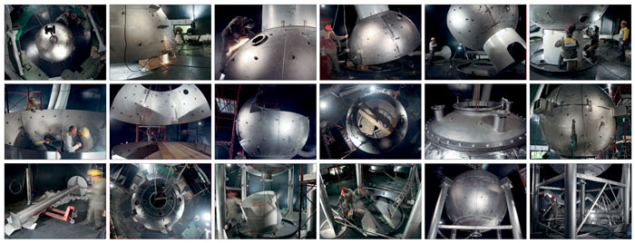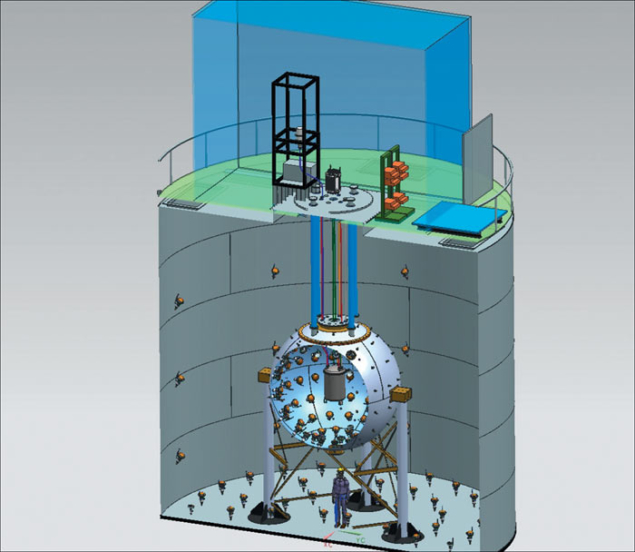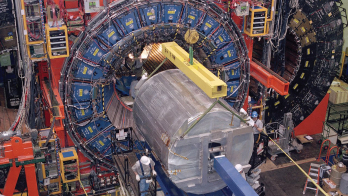Towards new levels of sensitivity in detecting dark-matter particles.

Image credit: Yury Suvorov for the DarkSide collaboration.
A programme of experiments based on innovative detectors aims to take dark-matter detection to a new level of sensitivity.
Dark energy and dark matter together present one of the most challenging mysteries of the universe. While explaining the first seems to be within the reach of only cosmologists and astrophysicists, the latter appears to be accessible also to particle physicists. One of the most recent and innovative experiments designed for the direct detection of dark-matter particles is DarkSide, a prototype for which – DarkSide 10 – is currently being tested in the Gran Sasso National Laboratory in central Italy. The first detector for physics – DarkSide 50 – is scheduled for commissioning underground in December this year.
Astronomical observations suggest that dark matter is made of a new species of non-baryonic particle, which must lie outside the Standard Model. These particles must also be neutral, quite massive, stable and weakly interacting – hence the acronym WIMPs, for weakly interacting massive particles. One of the most promising candidates for a dark-matter particle is the neutralino, the lightest particle that is predicted in theories based on supersymmetry. However, constraints from recent measurements by experiments at CERN’s LHC suggest that WIMPs may have a different origin.
Several potential background sources can mimic the interaction between dark-matter particles and nuclei.
A powerful way of detecting WIMPs directly in the local galactic halo is to look for the nuclear recoils produced when they collide with ordinary matter in a sensitive detector. However, WIMP-induced nuclear recoils are difficult to detect. Theory indicates that they would be extremely rare, with some 10 events expected per year in 100 kg of liquid argon for a WIMP mass of 50 GeV/c2 and a WIMP–nucleon cross-section of 10–45 cm2. They would also produce energy deposits below the order of 100 keV. Moreover, there are several potential background sources that can mimic the interaction between dark-matter particles and nuclei.
Sources of background
In a typical target, there are three main sources of background at energies up to tens of kilo-electron-volts: natural β and γ radioactivity, which induces electron recoils; α decays on the surface of the target in which the daughter nucleus recoils into the target and the α particle remains undetected; and nuclear recoils produced by the elastic scattering of background neutrons. This latter process is nearly indistinguishable from the signals expected for WIMPs and requires an efficient neutron veto in the apparatus.

Image credit: DarkSide collaboration.
DarkSide is a new experiment that uses novel techniques to suppress background sources as much as possible, while also understanding them well. The programme centres on a series of detectors of increasing mass, each making possible a convincing claim for the detection of dark matter based on the observation of a few well characterized nuclear-recoil events in an exposure of several years. The design concept involves a two-phase, liquid-argon time-projection chamber (LAr-TPC) in which the energy released in WIMP-induced nuclear recoils can produce both scintillation and ionization. Arrays of photomultiplier tubes at the bottom and top of the cylindrical active volume detect the scintillation light. A pair of novel transparent high-voltage electrodes and a field cage provide a uniform drift field of about 1 kV/cm to extract the ionization produced. A reflective, wavelength-shifting lining renders the scintillation light from the argon (wavelength 128 nm) visible to the photomultipliers.
In a two-phase argon TPC, rejection of background comes from three independent discrimination parameters: pulse-shape analysis of the direct liquid-argon scintillation signal (S1); the ratio of ionization produced in an event to scintillation, where the former is read out by extracting ionization electrons from the liquid into the gaseous argon phase, where they are accelerated and emit light through electroluminescence (S2); and reconstruction of the event’s location in 3D using the TPC. The z co-ordinates for the event are determined by the time delay between S2 and S1, while the transverse co-ordinates are determined through the distribution of the S2 light across the layer of photomultiplier tubes.
As in other experiments searching for rare events, DarkSide’s detectors will be constructed using materials with low intrinsic radioactivity. In particular, the experiment uses underground argon with extremely low quantities of 39Ar, which is present in atmospheric argon at levels of about 1Bq/kg as a result of the interaction of cosmic rays, primarily with 40Ar. The DarkSide collaboration has developed processes to extract argon from underground gas wells, where the proportion of 39Ar is low. A particularly good source of underground argon is in the Kinder Morgan Doe Canyon Complex in Colorado. The CO2 natural gas extracted there contains about 600 ppm of argon. The DarkSide collaboration has operated an extraction facility at the Kinder Morgan site since February 2010; it has to date extracted some 90 kg of underground depleted argon and subsequently distilled 23 kg to about 99.99% purity. (The throughput is about 1 kg/day, with 99% efficiency.) Studies of the residual 39Ar content of the distilled gas with a low-background detector at the Kimballton Underground Research Facility, Virginia, give an upper limit for the 39Ar content equivalent to 0.6% of the 39Ar in atmospheric argon.
It is not only the argon that has to have low intrinsic radioactivity. Nuclear recoils produced by energetic neutrons that scatter only once in the active volume form a background that is, on an event-by-event basis, indistinguishable from dark-matter interactions. Neutrons capable of producing these recoil backgrounds are created by radiogenic processes in the detector material. In detectors made from clean materials, the dominant source of the radiogenic neutrons is typically the photodetectors, so ultralow background photodetectors are another important goal for DarkSide. A long-term collaboration with the Hamamatsu Corporation has resulted in the commercialization of 3-inch photomultiplier tubes with a total γ activity of around only 60 mBq per tube, with a further 10-fold reduction foreseen in the near future.
To measure and exclude neutron background produced by cosmic-ray muons, the DarkSide TPC will be deployed within an active neutron veto based on liquid scintillator, which will in turn be deployed within 1000 m3 of water in a tank 10 m high and 11 m in diameter, which was previously used in the Borexino Counting Test Facility at Gran Sasso. The liquid-scintillator neutron veto is a unique feature of the DarkSide design and is filled with ultrapure, boron-loaded organic scintillator, which has been distilled using the purification system of the Borexino experiment. The water serves as a Cherenkov detector to veto muons. Monte Carlo simulations suggest that with this combined veto system, the number of neutron events generated by cosmic-rays at the depth of the Gran Sasso Laboratory should be negligible, even for exposures of the order of tonne-years.
The DarkSide programme will follow a staged approach. The collaboration has been operating DarkSide 10, a prototype detector with a 10 kg active mass, in the underground laboratory at Gran Sasso since September 2011. This has been a valuable test bed during the construction of the veto system. It has allowed the light-collection, high-voltage and TPC field structures – and the data-acquisition and particle-discrimination analysis systems – to be optimized using γ and americium-beryllium sources. The first physics detector in the programme, DarkSide 50, should be deployed inside the completed veto system in the Gran Sasso Laboratory by the end of 2012. Looking forward to the second generation, upgrades to the underground argon plants are planned, and the nearly completed veto system has been designed to accommodate a DarkSide-G2 detector, which will have a fiducial mass of 3.5 tonnes.







